| Asparagus officinalis - Cultivars | |
|---|---|
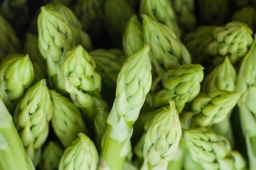 Fig. 1  Green asparagus 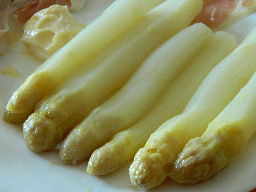 Fig. 2  White asparagus 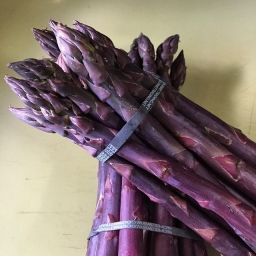 Fig. 3  Purple asparagus | The list of commonly available
varieties has significantly changed in recent years. Standard varieties
like Mary Washington, Martha Washington and Waltham Washington are
still being offered; but a number of new varieties that are either
predominantly or all male recently have been introduced in to common
usage.
12 The female plants bear seeds, which take considerable energy from the plant and sprout new seedlings, which cause overcrowding in the bed. Male plants produce thicker, larger spears because they put no energy into seeds and have no weedy seedling problem. A line that produces only male plants was discovered and has been incorporated into some truly amazing varieties. Jersey Giant, Jersey Knight, Jersey Prince, Syn 53, Syn 4-362, UC 157 and Viking KBC are new hybrids with larger yields. 12 It is advisable to plant the best variety available, as an asparagus bed should remain productive for at least 15 to 20 years, [remember they are short lived in warmer climates]. If you are starting a new bed, you may never get to choose a variety again if your bed produces that long. All the newer varieties are cold tolerant and are resistant to rust and fusarium wilt. 12 White White (blanched) asparagus is traditionally grown in Europe by mounding up the adjacent soil over the asparagus rows in the spring before the spears emerge to a height of 10 to 12 inches. Once the tip of the spear emerges through the mounded soil, it is cut off at the base by digging into the mound. This is very labor intensive. 9 White asparagus does have a slightly sweeter taste and has less fiber than green asparagus. In parts of Europe, especially Germany and the Netherlands this is the primary way that asparagus is grown and consumed. 2 Purple Purple asparagus is a variety, or rather a couple of varieties. Purple Passion, Pacific Purple and others are mutant strains bred to be purple in color, although the asparagus turns green when it is cooked. These varieties tend to send out bigger but fewer spears. 2 A note from Thailand Most asparagus cultivars are being introduced by private companies. They have been selected for suitability to the tropics. They are recommended as being disease tolerant, with large tips, tender flesh, and good flavour. Such cultivars are grouped as follows: Open Pollination Cultivars: California 309, California 500 and Mary Washington. F1 Hybrid Cultivars: Brock's Improved and Imperial (UC 157). 11 Replicated Asparagus Cultivar Evaluation - 2007-2012, North Carolina State University pdf |
| A. officinalis 'Andreas' | |
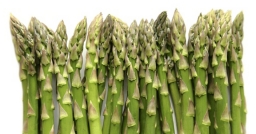 | A. officinalis 'Apollo' F1 (Fig. 4) High yield, heat-tolerant, vigorous Medium to large diameter spears Attractive dark green spears with slight purple at tip and butt of spear Cylindrical shaped spears with slight tapering and overall smooth appearance Well received in the fresh, processing and freezing industries Very tight heads under cool to warm growing conditions High tolerance to fusarium and rust Moderate tolerance to blight Possible cultivation in cool to warm climates For green spear production, a planting density of 6 in. (15 cm) is normally practiced 3,10 |
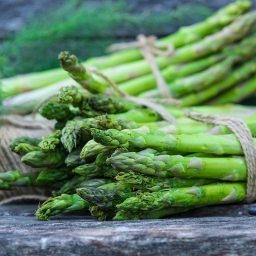 | A. officinalis
'AsparaBest'
®
(Fig. 5) Larger yield from predominantly male plants Outproduces Jersey varieties 2 to 3 times over Great for chilly Northern climates Excellent flavor It's called "AsparaBest®" for a reason! This delicious asparagus outperforms any other variety currently available, especially when it comes to flavor. The predominately male plants produce little to no seed to ensure larger yields, since all the plants' energy goes into spear production and healthy root development. AsparaBest outproduces popular Jersey varieties 2 to 3 times over! Regardless of your location, this sweet, crisp variety is unmatched in Northern climates for cold tolerance, and will live and produce longer than any other variety. Since you'll have so much to harvest, be sure to try cooking the spears with our Asparagus Steamer, which will steam them to perfection in just minutes. 6 A. officinalis 'Ariane' |
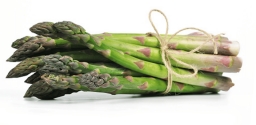 | A. officinalis 'Atlas' F1™ (Fig. 6) Tolerant to fusarium, rust, blight and cercospora foliar diseases High yield, heat-tolerant, vigorous When grown under tunnels, becomes an early type 20-50% higher yielding than UC 157 F1 Medium to large green spears with slight purple at the tip and butt For use in both green and white production Tightly headed for smooth appearance; tapering spears with cylindrical shape Maintains tight head under hot growing conditions Recommendations: For green spear production, a planting depth of 6 in. (15 cm) is normally practiced Preferable cultivation in temperate to warm climate Growing under plastic tunnels can significantly improve early performance and be protected from Phomopsis asp. disease Recommended planting density for green asparagus is 26,000 – 30,000 plants per hectare; for white asparagus is 18,000 – 22,000 plants per hectare Atlas F1™ is an excellent high-yielding asparagus variety for use in both green and white production. 3,10 A. officinalis 'Backlim' A. officinalis 'Centennial' A. officinalis 'Cipres' A. officinalis 'Cito' A. officinalis 'Conover's Colossal' A. officinalis 'Dariana' A. officinalis 'Dartagnan' A. officinalis 'De Paoli' A. officinalis 'Dulce Verde' A. officinalis 'Eros' A. officinalis 'Fileas' A. officinalis 'Gijnlim' A. officinalis 'Ginger' |
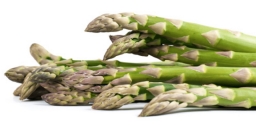 | A. officinalis 'Grande' F1™ (Fig. 7) Early and vigorous growth Excellent yielder early through late in the cutting season Very attractive medium-large to large diameter spears (larger than Atlas F1™, Apollo F1 and UC 157 F1) Green with little purple coloration on the bud scales, tip and butt For use in both green and white production Very tight heads for smooth appearance; cylindrical shape with slight tapering spear tips Maintains very tight head under warm to hot growing conditions Can be grown under plastic tunnels even in warm to hot conditions High tolerance to fusarium, rust, blight and other foliar diseases Free of AV II Recommendations: Preferable cultivation in warm to hot growing conditions even under plastic tunnels Phomopsis asp. can be prevented when grown under plastic tunnels For green spear production, a planting depth of 6 in. (15 cm) is normally practiced Recommended planting density for green asparagus is 26,000 – 30,000 plants per hectare; for white asparagus is 18,000 – 22,000 plants per hectare. 3 A. officinalis 'Guelph Millennium' |
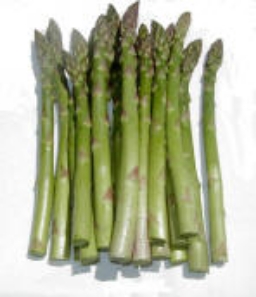 | A. officinalis 'Ida Lea' F1 (Fig. 8) Developed by Frank Takatori and Frank Southers at the University of California at Riverside for fresh market, green asparagus production in desert climates. Ida Lea F1 is an all-green variety, producing a spear that is 10-20% larger than UC 157. One of the features that sets this variety apart from other asparagus varieties is its ability to maintain a tight, well tapered head in the hottest asparagus production regions in the world. In normal spring conditions, Ida Lea does not initiate lateral branches until the spear has maintained a height of 12 inches. This is a highly desirable characteristic in hot climates. With Ida Lea F1, the grower produces early spears that are all-green, with tight, tapering heads. The lack of purplish coloring in Ida Lea (like UC 157) helps distinguish it from other asparagus varieties. Many markets will not accept spears produced with a purplish tint on the heads. This variety is tolerant of Rust (Puccinia asparagi) and highly tolerant of Fusarium (Fusarium oxysporum). Seed produced by Cutter Asparagus is tested and found free of Latent Virus 2. F2 (open pollinated seed) of Ida Lea asparagus is not true to type, and the resulting plants will exhibit variability. This results in a lower quality product as well as a shorter-lived field due to break down in tolerance to Fusarium. 1 A. officinalis 'Jersey Gem' A. officinalis 'Jersey General' |
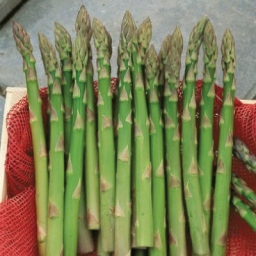 | A.
officinalis 'Jersey
Giant' (Fig. 9) High yield, rust-resistant, crown rot-resist, tolerant to Fusarium wilt. Jersey Giant roots produces an abundance of flavorful, succulent and giant spears. Can produce up to twice the yield of standard varieties. Jersey Giant grows well throughout the United States. 5,10 A. officinalis 'Jersey King' |
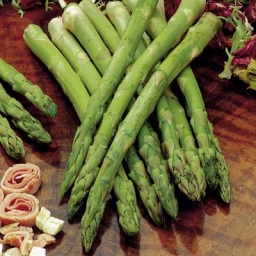 | A.
officinalis 'Jersey
Knight' (Fig. 10) High yield, rust-resistant, tolerant to Fusarium wilt and crown and root rot The Jersey Knight asparagus is a very productive and great tasting plant. These roots grow tall stalks that can yield up to 3-4 times more asparagus than other varieties. Predominantly male, produces high yields, and produces well in warmer climates. Jersey Knight produces the best spear quality of all the Jersey hybrids. Green spears with purple bracts. 5,10 A. officinalis 'Jersey Prince' |
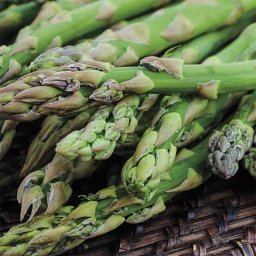 | A.
officinalis 'Jersey
Supreme' (Fig. 11) High yield, rust-resistant, tolerant to Fusarium wilt Tender but crisp stalks Early harvest High yield Cold-hardy When springtime comes around, these large Jersey Supreme Asparagus spears are some of the first veggies you can harvest from your garden! This all-male variety of giant asparagus. 6,10 A. officinalis 'Larac' A. officinalis 'Lucullus' A. officinalis 'Martha Washington', older, heirloom variety 10 A. officinalis 'Mary Washington', older, heirloom variety 10 |
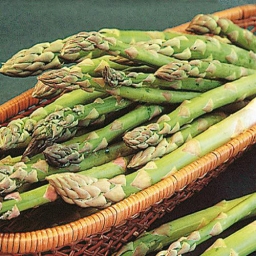 | A. officinalis 'Mary
Washington Improved' (Fig. 13) Improved Yields from an Old Fashioned Favorite The best of the open-pollinated varieties. Produces higher yields with tighter tips than the original Mary Washington; same outstanding flavor. Not high-heat tolerant, so be sure to cut spears on the short side. At temperatures over 70°F, taller spears may become tough and woody. 7 |
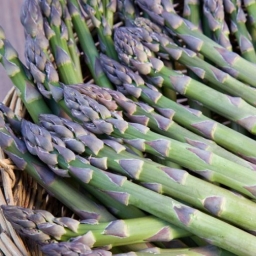 | A.
officinalis 'Millenium'
(Fig. 14) Cold-tolerant. Millennium asparagus, developed by at Univ. of Guelph, Canada, has become a very popular asparagus in Canada and United States. In our trial [Indiana], Millennium has been productive, with high quality spears, tender, and has good flavor. Can be grown successfully in a wide range of soil types. 5,10 A. officinalis 'Orane' |
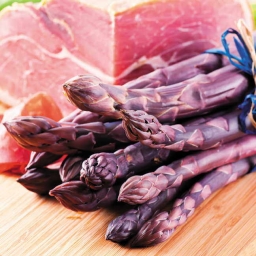 | A. officinalis 'Pacific Purple'
(Fig. 15) The Biggest Crops of Any Purple! Extra-thick spears keep their color even in hot weather. Genus: Asparagus Species: officinalis Variety: Pacific Purple Item Form: Pack of 10 Zone: 3 - 9 Days To Maturity: 750 Fruit Color: Purple Habit: Upright Plant Height: 4 ft - 5 ft Plant Width: 12 in - 2 ft 6 in 8 A. officinalis prostratus ssp. |
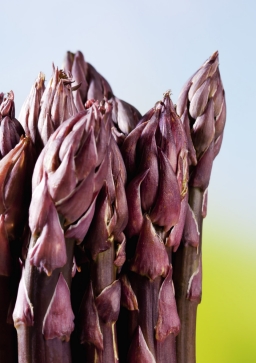 | A. officinalis 'Purple Passion' F1
(Fig. 16) Sweet, tender shoots. Produces unique purple spears. Suitable for growing in cool to warm climates Burgundy/purple colored Low fiber spear with creamy green interior Tightly compressed bud scales with tight, rounded tip Later spear production protects from early frost damage Mild and sweet tasting with 20% greater sugar content than green spears Large diameter spears (larger than Atlas F1™, Apollo F1, UC 157 F1, and Grande F1™) Tolerant to fusarium but susceptible to rust Great for specialty and gourmet retail markets and restaurant trade Possible cultivation in cool to warm climates Recommended planting density as for green asparagus, i.e. 26,000 – 30,000 plants per hectare A planting depth of 6 in. (15 cm) is normally practiced 3,10 |
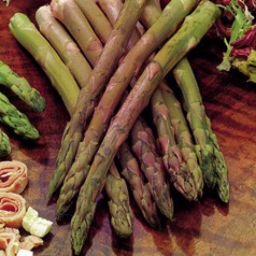 | A.
officinalis 'Rosalie'
(Fig. 17) The Rosalie Asparagus is a large, purple-colored variety that will actually turn pink after harvest if picked when it is white! This tender variety is 80% all male and is is mid-early with prolific yields. Rosalie has a nice flavor and is resistant to rust and stemphylium. 5 A. officinalis 'Saxon' A. officinalis 'Spearhead' A. officinalis 'Stewart's Purple' A. officinalis 'Supermale' |
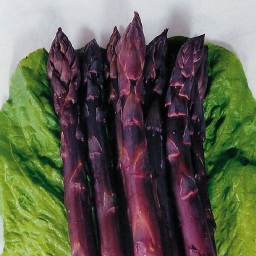 | A. officinalis 'Sweet Purple' (Fig.
18) This new type of asparagus has many characteristics of green asparagus but offers something new for the asparagus connoisseur. The spears produced by Sweet Purple have several qualities which make it quite different than common green asparagus. The deep-burgundy coloration produced in these spears is the most striking difference between the purple and green varieties.* The spears are generally larger and much more tender than its green counterpart. The vascular bundles have less lignin per spear, which make the spears less stringy. This allows the cook to use the entire spear with very little waste. Sweet purple asparagus has 20% higher sugar content. Because of this extra sweetness, this vegetable is often eaten raw. Some upscale restaurants garnish salads with purple asparagus. When cooked, the sweetness gives this asparagus a mild, nutty flavor. Growing Tips that are unique to Sweet Purple Asparagus Keep the humidity low within the canopy. This variety is susceptible to rust. a) Use drip or buried drip if possible b) Avoid use of overhead sprinklers c) Plant rows so that the prevailing winds move down the row, keeping the plants drier. Use mulch and/or pre-emergent herbicides for weed suppression. Due to lack of fiber in the spears, the fern tends to lie down in the furrows, making weed control difficult. (The lack of fiber in the spears is the reason Sweet Purple is so tender). * Applying vinegar or lemon juice to spears prior to cooking will help to retain the purple coloration. Otherwise, cooking this variety will result in varying degrees of color loss. 1 |
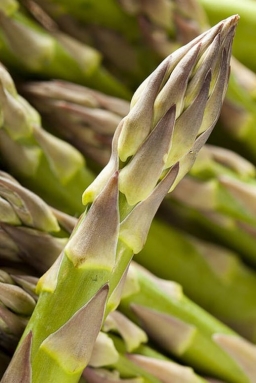 | A.
officinalis 'UC
157' F1 (Fig. 19) Tried and true clonal hybrid Very early spear emergence Set standard for yield and spear quality for fresh green asparagus All green, smooth, tight-tipped, medium spear diameter Predominant cultivar in California, Peru, Mexico and other areas with moderate to hot climatic conditions For use in both green and white production High tolerance to fusarium and moderate tolerance to rust and blight Free of AV II Recommendations: For green spear production, a planting depth of 15cm is normally practiced World’s standard variety, preferable cultivation in moderate to hot conditions Recommended planting density for green asparagus is 26,000 – 30,000 plants per hectare; for white asparagus is 18,000 – 22,000 plants per hectare UC 157 F1 excels in climates with moderate to hot conditions like California, Peru and Mexico. UC 157 F1 has set the standard for yield and spear quality in the fresh market. UC 157 F1 is tested for genetic purity and seed block inspected and certified by the California Crop Improvement Association. 3 A. officinalis 'UC-17' A. officinalis 'UC-72' A. officinalis 'Viking KB3' A. officinalis 'Violetta d'Albenga' |
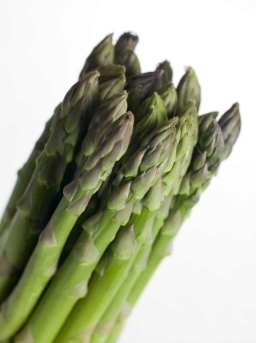 Back to Asparagus Page | A.
officinalis 'Walker Deluxe' F1
(Fig. 22) Adapted to temperate, warm and cool climates Early season variety All-male hybrid with very high yield potential Medium green spear with slightly purple bracts Tight headed for smooth appearance For use in fresh, processing and freezing industries High tolerance to rust, fusarium and other foliar diseases Recommendations: For green spear production, a planting depth of 6 in. (15 cm) is normally practiced Possible cultivation in cool to warm climates Recommended planting density for green asparagus is 26,000 – 30,000 plants per hectare Walker Deluxe F1 is a high-yielding male hybrid variety that is adapted to both warm and cool climate conditions. 3 |
| Bibliography 1 "Ida Lea F1. Sweet Purple." Cutter Asparagus Seed, asparagusseed.com/. Accessed 12 Jan 2020. 2 Myers, Norm. "Asparagus in the home garden." Growing Asparagus, Michigan Asparagus, www.michiganasparagus.org/growing-asparagus. Accessed 11 Jan. 2020. 3 "Varieties." Walker Brothers. Seeds and Plants, walkerseed.com. Accessed 12 Jan 2020. 5 "Asparagus." Urban Farmer, www.ufseeds.com/product-category/vegetables/asparagus/. Accessed 15 Jan. 2020. 6 "Asparagus." Gardens Alive, www.gardensalive.com/category/asparagus-plants. Accessed 15 Jan. 2020. 7 "Asparagus." Gurney's Seed and Nursery, www.gurneys.com/product/mary_washington_improved_asparagus. Accessed 15 Jan. 2020. 8 "Asparagus." Park Seed, parkseed.com/asparagus/c/asparagus/. Accessed 16 Jan. 2020. 9 Cantaluppi, Carl J., et al. "Asparagus: A Small-Scale Agriculture Alternative." Small Farm Program, USDA Division of Agriculture and Natural Resources, Cooperative State Research Service, Feb. 1994, UC Davis, sfp.ucdavis.edu/pubs/brochures/Asparagus/. Accessed 18 Jan. 2020. 10 Walker, Stephanie. "Asparagus Production in New Mexico." Cooperative Extension Service, College of Agricultural, Consumer and Environmental Science, New Mexico State University, Guide H-227, NMSU, aces.nmsu.edu/pubs/_h/H227/welcome.html. Accessed 18 Jan. 2020. 11 Nath, Prem, et al. "Asparagus (Asparagus officinalis L.)” The Vegetable Sector In Thailand A Review. Food and Agriculture Organization of the United Nations, 1999, FAO Corporate Document Repository, www.fao.org/3/ac145e/ac145e00.htm. Accessed 24 Dec. 2017. 12 "Asparagus officinalis L. var. altilis." hortanswers, University of Illinois Extension, web.extension.illinois.edu/hortanswers/plantdetail.cfm?PlantID=286&PlantTypeID=9. Accessed 15 Jan. 2020. Photographs Fig. 1 Adams, Ryan. "Asparagus close-up." homedust.com, 27 June 2018, flickr, (CC BY 2.0), www.flickr.com/photos/. Accessed 27 Jan. 2020. Fig. 2 Basotxerri. "Espárragos cocidos con mayonesa y jamón serrano." 13 April 2014, Wikimedia Commons, (CC BY-SA 4.0), commons.wikimedia.org/wiki/File:Espárragos_con_mayonesa_y_jamón.JPG. Accessed 21 Dec. 2019. Fig. 3 Dettwiler, Glenn. "Score.... Purple Asparagus!" 25 May 2015, flickr, (CC BY 2.0), www.flickr.com/photos/swisschef/. Accessed 27 Jan. 2020. Fig. 4 "Apollo F1™." Walker Brothers. Seeds and Plants, walkerseed.com/apollo-f1/. Accessed 15 Jan 2020. Fig. 5 "AsparaBest® Asparagus." Gardens Alive, www.gardensalive.com/product/asparabest-asparagus. Accessed 15 Jan. 2020. Fig. 6 "Atlas F1™." Walker Brothers. Seeds and Plants, walkerseed.com/atlas-f1tm/. Accessed 12 Jan 2020. Fig. 7 "Grande F1™." Walker Brothers. Seeds and Plants, walkerseed.com/grande-f1tm/. Accessed 13 Jan 2020. Fig. 8 "Ida Lea F1." Cutter Asparagus Seed, asparagusseed.com/idaleaf1.htm. Accessed 12 Jan 2020. Fig. 9 "Jersey Giant." Urban Farmer, www.ufseeds.com/product/millennium-asparagus-roots/. Accessed 15 Jan. 2020. Fig. 10 "Jersey Knight, Asparagus Roots." Urban Farmer, www.ufseeds.com/product/jersey-knight-asparagus-roots/. Accessed 15 Jan. 2020. Fig. 11 "Jersey Supreme Asparagus." Gardens Alive, www.gardensalive.com/product/jersey-asparagus-supreme. Accessed 15 Jan. 2020. Fig. 13 "Mary Washington Improved Asparagus." Gurney's Seed and Nursery, www.gurneys.com/product/mary_washington_improved_asparagus. Accessed 15 Jan. 2020. Fig. 14 "Millennium." Urban Farmer, www.ufseeds.com/product/millennium-asparagus-roots/. Accessed 15 Jan. 2020. Fig. 15 "Pacific Purple Asparagus Plants." Park Seed, parkseed.com/pacific-purple-asparagus-plants/p/35674-PK-10/. Accessed 16 Jan. 2020. Fig. 16 "Purple Passion' F1." Walker Brothers. Seeds and Plants, walkerseed.com/purple-passion/. Accessed 12 Jan 2020. Fig. 17 "Rosalie Asparagus Roots." Urban Farmer, www.ufseeds.com/product/jersey-knight-asparagus-roots/. Accessed 15 Jan. 2020. Fig. 18 "Sweet Purple Asparagus Seeds." Park Seed, parkseed.com/sweet-purple-asparagus-seeds/p/52495-PK-P1/. Accessed 15 Jan. 2020. Fig. 19 "UC 157 F1." Walker Brothers. Seeds and Plants, walkerseed.com/uc-157-f1/. Accessed 12 Jan 2020. Fig. 22 'Walker Deluxe F1." Walker Brothers. Seeds and Plants, walkerseed.com/walker-deluxe/. Accessed 15 Jan 2020. Published 1 Feb. 2020 KJ | |